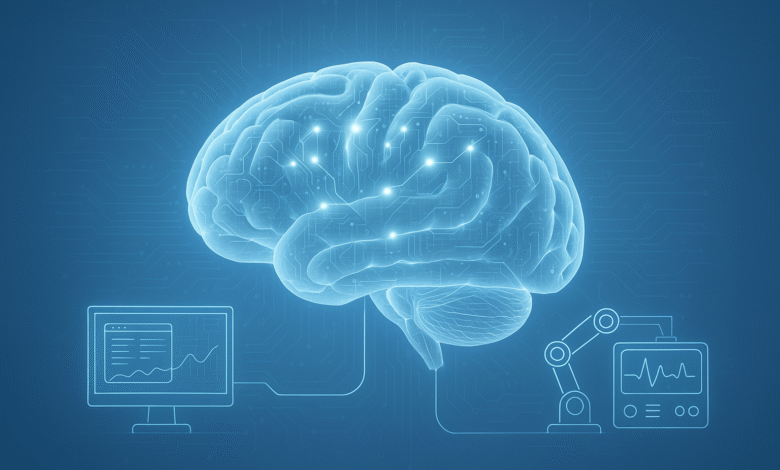What Is Neurotechnology? The Future of Brain-Computer Interfaces
Discover what is neurotechnology and how brain-computer interfaces are revolutionizing medicine, treating neurological disorders, and enhancing human capabilities.

Imagine controlling your smartphone with just your thoughts, or helping paralyzed patients move robotic limbs through brain signals alone. This isn’t science fiction anymore—it’s the reality of neurotechnology, one of the most exciting fields transforming how we understand and interact with the human brain.
What is neurotechnology? Simply put, neurotechnology is the field that combines neuroscience with engineering to create devices and systems that can interact directly with the nervous system. These cutting-edge technologies can read brain signals, stimulate neural activity, and even help restore lost functions in people with neurological conditions.
Understanding the Basics of Neurotechnology
Neurotechnology encompasses a wide range of brain-computer interfaces, neural implants, and medical devices designed to monitor, repair, or enhance the nervous system. At its core, this field bridges the gap between our biological brain and digital technology.
The human brain contains approximately 86 billion neurons that communicate through electrical and chemical signals. Neurotechnology devices can detect these signals, interpret them, and translate them into commands that computers or other devices can understand. This two-way communication opens up incredible possibilities for treating neurological disorders and enhancing human capabilities.
Brain-computer interfaces represent the most well-known application of neurotechnology. These systems create a direct communication pathway between the brain and external devices, bypassing traditional routes like muscles and nerves. The technology has evolved from basic research tools to sophisticated medical devices that can dramatically improve patients’ quality of life.
Types of Neurotechnology Systems
Non-Invasive Neurotechnology
Non-invasive neurotechnology systems work from outside the skull, making them safer and easier to use than surgical alternatives. Electroencephalography (EEG) is the most common example, using electrodes placed on the scalp to detect brain activity. These systems are widely used in hospitals for monitoring brain function and diagnosing conditions like epilepsy.
Functional magnetic resonance imaging (fMRI) and near-infrared spectroscopy are other non-invasive approaches that can monitor brain activity in real-time. While these methods are safer, they typically offer lower resolution and slower response times compared to invasive alternatives.
Transcranial magnetic stimulation (TMS) represents another category of non-invasive neurotechnology that can stimulate specific brain regions using magnetic fields. This approach is FDA-approved for treating depression and is being researched for other neurological conditions.
Invasive Neurotechnology
Invasive neurotechnology requires surgical procedures to place devices directly on or in the brain tissue. These systems can provide much more precise control and better signal quality than non-invasive alternatives.
Deep brain stimulation (DBS) is perhaps the most successful example of invasive neurotechnology currently in use. Surgeons implant electrodes deep in the brain to treat conditions like Parkinson’s disease, essential tremor, and dystonia. Over 160,000 people worldwide have received DBS implants, with many experiencing significant symptom improvement.
Neural implants that record brain signals are becoming increasingly sophisticated. Companies like Neuralink, Synchron, and Blackrock Neurotech are developing brain implants that can decode movement intentions, allowing paralyzed patients to control computer cursors, robotic arms, and even communicate through thought alone.
Real-World Applications of Neurotechnology
Medical Treatments and Therapies
Neurotechnology is revolutionizing medical treatment for numerous neurological conditions. Cochlear implants have already helped over 700,000 people with hearing loss regain the ability to perceive sound. These devices bypass damaged parts of the inner ear and directly stimulate the auditory nerve.
For stroke patients, neurotechnology offers hope for recovery. Brain stimulation techniques can help rewire neural connections, potentially restoring lost functions. Some patients have regained movement in paralyzed limbs through targeted stimulation combined with rehabilitation therapy.
Epilepsy treatment has also benefited from neurotechnology advances. Responsive neurostimulation systems can detect seizure activity and deliver targeted electrical pulses to prevent seizures before they fully develop.
Assistive Technologies for Disabilities
One of the most promising applications of neurotechnology is helping people with severe disabilities regain independence. Brain-controlled prosthetics allow amputees to control artificial limbs using their thoughts, providing much more natural movement than traditional prosthetics.
Communication devices powered by brain signals are helping people with conditions like ALS (Lou Gehrig’s disease) who have lost the ability to speak or move. These systems can translate thoughts into text or speech, maintaining vital social connections and independence.
Spinal cord injury patients are benefiting from neurotechnology that can bypass damaged neural pathways. Some experimental systems can record movement intentions from the brain and stimulate muscles or external devices to restore basic motor functions.
Cognitive Enhancement and Monitoring
Beyond medical applications, neurotechnology is exploring ways to enhance normal brain function. Brain training systems using real-time feedback can help improve attention, memory, and other cognitive abilities.
Sleep monitoring devices using neurotechnology can track brain activity during sleep, helping optimize rest and identify sleep disorders. Some systems can even deliver targeted stimulation to enhance deep sleep phases.
Mental health applications are also emerging, with neurofeedback systems helping treat conditions like ADHD, anxiety, and PTSD by teaching patients to control their brain activity patterns.
Current Challenges in Neurotechnology
Technical Limitations
Despite impressive progress, neurotechnology still faces significant technical challenges. Signal quality degrades over time as scar tissue forms around implanted electrodes. Current systems can only monitor a small fraction of the brain’s neurons, limiting their effectiveness.
Battery life remains a concern for implanted devices. Most current systems require periodic surgical procedures to replace batteries, though newer wireless charging approaches show promise for solving this problem.
Data processing and interpretation represent another major challenge. The brain generates enormous amounts of complex data that require sophisticated algorithms to decode meaningful patterns. Machine learning and artificial intelligence are helping address these challenges but still have limitations.
Safety and Ethical Concerns
The safety of invasive neurotechnology requires careful consideration. Brain surgery always carries risks, and long-term effects of chronic brain stimulation are not fully understood. Regulatory agencies like the FDA carefully evaluate these devices before approval.
Privacy and security concerns are growing as neurotechnology becomes more sophisticated. Brain data represents the most personal information possible, raising questions about who can access this data and how it should be protected.
Ethical questions about cognitive enhancement are also emerging. Should healthy people be allowed to use neurotechnology to enhance their mental abilities? How do we ensure fair access to these potentially life-changing technologies?
The Future of Brain-Computer Interfaces
Emerging Technologies
The next generation of neurotechnology promises even more impressive capabilities. Researchers are developing injectable neural mesh that could monitor brain activity with minimal invasiveness. These ultra-thin, flexible devices could provide high-resolution brain monitoring without the risks of traditional brain surgery.
Optical approaches using light instead of electricity show promise for more precise neural stimulation with fewer side effects. These optogenetic techniques require genetic modification of neurons but offer unprecedented control over brain activity.
Wireless power and data transmission could eliminate the need for physical connections through the skull, reducing infection risks and improving patient comfort. Some experimental systems already demonstrate wireless operation over short distances.
Also Read: Machine Learning vs Deep Learning: What’s the Real Difference?
Integration with Artificial Intelligence
The combination of neurotechnology with artificial intelligence is creating powerful new possibilities. AI algorithms can learn to decode brain signals more accurately over time, adapting to each individual user’s unique neural patterns.
Machine learning systems can also predict brain states and deliver preventive treatments. For example, AI might detect early signs of seizure activity and automatically trigger interventions before symptoms appear.
Neural networks inspired by brain function are being integrated directly with biological neural networks, creating hybrid systems that combine the best aspects of both biological and artificial intelligence.
Potential Societal Impact
As neurotechnology becomes more accessible and powerful, it could fundamentally change how we interact with technology and each other. Direct brain-to-brain communication might become possible, allowing people to share thoughts and experiences directly.
Educational applications could revolutionize learning by directly transferring knowledge or enhancing memory formation. Students might be able to learn complex subjects much faster than traditional methods allow.
Workplace applications could enhance human performance in demanding jobs like surgery, piloting, or air traffic control. Workers could receive direct neural feedback to improve accuracy and reaction times.
Market Growth and Industry Outlook
The global neurotechnology market is experiencing rapid growth, with projections suggesting it could reach over $20 billion by 2030. This growth is driven by aging populations, increasing neurological disorders, and advancing technology capabilities.
Major technology companies are investing heavily in neurotechnology research. Google, Facebook (Meta), Microsoft, and others are exploring brain-computer interfaces for future computing platforms.
Startup companies are driving much of the innovation in this space. Companies like Neuralink have attracted significant funding and media attention, while others focus on specific medical applications or non-invasive approaches.
Regulatory Landscape and Standards
Neurotechnology regulation varies significantly across different countries and applications. Medical devices require extensive testing and approval processes, while consumer neurotechnology products face less stringent requirements.
The FDA has established pathways for approving neurotechnology devices, with different requirements for different risk levels. Class III devices that pose the highest risks require the most extensive clinical testing before approval.
International standards organizations are working to establish common guidelines for neurotechnology safety, effectiveness, and interoperability. These standards will become increasingly important as the technology becomes more widespread.
Getting Involved in Neurotechnology
For those interested in pursuing careers in neurotechnology, the field offers opportunities across many disciplines. Engineers, neuroscientists, computer scientists, and medical professionals all play important roles in advancing these technologies.
Educational programs combining neuroscience with engineering are becoming more common at universities worldwide. These interdisciplinary programs prepare students for careers at the intersection of brain science and technology.
Patient advocacy groups play a crucial role in guiding neurotechnology development toward addressing real-world needs. Many organizations support research and help connect patients with experimental treatments.
Conclusion
Neurotechnology represents one of the most exciting frontiers in modern science and medicine. From helping paralyzed patients control robotic limbs to treating severe depression with brain stimulation, these technologies are already changing lives and offering hope for millions of people with neurological conditions.
What is neurotechnology? It’s the bridge between our biological brains and digital technology, opening up possibilities that seemed impossible just decades ago. As the field continues to advance, we can expect even more remarkable breakthroughs that will transform medicine, enhance human capabilities, and deepen our understanding of the most complex organ in the known universe.
The future of brain-computer interfaces holds immense promise, but realizing this potential will require continued research, careful attention to safety and ethics, and collaboration across multiple disciplines. As we stand on the brink of a new era in human-computer interaction, neurotechnology will undoubtedly play a central role in shaping our technological future.
Whether through medical treatments, assistive technologies, or cognitive enhancement applications, neurotechnology is poised to become an integral part of our lives. Understanding these technologies and their implications will be increasingly important as we navigate this exciting new frontier at the intersection of mind and machine.











